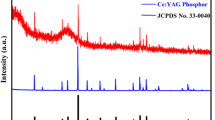Abstract
The red-emitting color conversion glasses were prepared by cosintering borosilicate glass frits and CaAlSiN3:Eu2+ phosphors at various temperatures in the 600–800 °C range. The effect of sintering temperature on the photoluminescence (PL) and excitation (PLE) of the color conversion glasses was investigated. Characteristics of color conversion glasses, with respect to excitation and emission intensity, quantum yield (QY) and CIE (Commission International de I’Eclairage) chromaticity were analyzed based on excitation and emission spectra. The glass, sintered at 600 °C, showed the best luminescence properties. Then, the intensity of excitation and emission peak decreased with the sintering temperature increasing. All excitation and emission peaks disappeared when the sintering temperature increased beyond 800 °C. The luminescence properties with the higher sintering temperature may be destroyed because of the lattice disturbance of CaAlSiN3 and oxidation of Eu2+, which is caused by reactions between glass matrices and CaAlSiN3:Eu2+ phosphors. The present study may promote the application of the red-emitting color conversion glasses in light emitting diodes encapsulation.





Similar content being viewed by others
References
N. Deopa, A.S. Rao, Spectroscopic studies of Sm3+ions activated lithium lead alumino borate glasses for visible luminescent device applications. Opt. Mater. 72, 31–39 (2017)
Y. Jin, Q. Wang, H. Zhou, L. Zhang, J. Zhang, Luminescence properties and high thermal stability of tuneable blue-green-emitting phosphor Gd4.67Si3O13: Ce3+, Tb3+. Ceram.Int. 42, 3309–3316 (2016)
J. Zhang, W. Zhang, Z. Qiu, W. Zhou, L. Yu, Z. Li, S. Lian, Li4SrCa(SiO4)(2):Ce3+, a highly efficient near-UV and blue emitting orthosilicate phosphor. J. Alloys Compd. 646, 315–320 (2015)
Z.B. Lin, H. Lin, J. Xu, F. Huang, H. Chen, B. Wang, Y.S. Wang, A chromaticity-tunable garnet-based phosphor-in-glass color converter applicable in w-LED. J. Eur. Ceram. Soc. 36, 1723–1729 (2016)
H. Yie, S. Kim, Y. Kim, H. Kim, Modifying optical properties of phosphor-in-glass by varying phosphor size and content. J. Non-Cryst. Solids 463, 19–24 (2017)
C. Yang, X.J. Liang, X.X. Di, P.Z. Li, G.C. Hu, R. Cao, W.D. Xiang, Facile fabrication and luminescence characteristics of Ce:YAG phosphor glass thick films coated on a glass substrate for white LEDs. Ceram. Int. 42, 14526–14532 (2016)
G.H. Li, J.J. Chen, Z.Y. Mao, W.W. Song, T. Sun, D.J. Wang, Atmospheric pressure preparation of red-emitting CaAlSiN3: Eu2+ phosphors with variable fluxes and their photoluminescence properties. Ceram. Int. 42, 1756–1761 (2016)
H. Chen, H. Lin, J. Xu, B. Wang, Z.B. Lin, J.C. Zhou, Y.S. Wang, Chromaticity-tunable phosphor-in-glass for long-lifetime high-power warm w-LEDs. J. Mater. Chem. C 3, 8080–8089 (2015)
R. Zhang, H. Lin, Y.L. Yu, D.Q. Chen, J. Xu, Y.S. Wang, A new-generation color converter for high-power white LED: transparent Ce3+:YAGphosphor-in-glass. Laser Photonics Rev. 8, 158–164 (2014)
Z.B. Lin, H. Lin, J. Xu, F. Huang, H. Chen, B. Wang, Highly thermal-stable warm w-LED based on Ce:YAG PiG stacked with a red phosphor layer. J. Alloys Compd. 649, 661–665 (2015)
K. Han, S. Lee, Y. Choi, W. Im, W. Chung, Improved color rendering index and thermal stability of white LEDs with phosphor-in-glass using the SiO2-B2O3-ZnO-Na2O glass system., J. Non-Cryst. Solids 445–446 77–80. (2016)
J.S. Zhong, D.Q. Chen, Y. Zhou, Z.Y. Wan, M.Y. Ding, Z.G. Ji, Stable and chromaticity-tunable phosphor-in-glass inorganic color converter for high-power warm white light-emitting diode. J. Eur. Ceram. Soc 36, 1705–1713 (2016)
Q.Q. Zhu, X.Xu,L. Wang, Z.F. Tian, Y.Z. Xu, ,N. Hirosaki, R.J. Xie, A robust red-emitting phosphor-in-glass (PiG) for use in white lighting sources pumped by blue laser diodes. J. Alloys Compd. 702, 193–198 (2017)
F. Le, L.X. Wang, W. Jia, D.Z. Jia, S.J. Bao, Synthesis and photoluminescence of Eu2+ by co-doping Eu3+ and Cl– in Sr2P2O7 under air atmosphere. J. Alloys Compd. 512, 323–327 (2012)
K. Shioi, N. Hirosaki, R.J. Xie, T. Takeda, Y.Q. Li, Synthesis, crystal structure and photoluminescence of Eu-α-SiAlON. J. Alloys Compd. 504, 579–584 (2010)
Acknowledgements
This work was supported by the National Natural Science Foundation of China (51302171), Science and Technology Commission of Shanghai Municipality (14500503300), Natural Science Foundation of Shanghai (12ZR1430900).
Author information
Authors and Affiliations
Corresponding authors
Rights and permissions
About this article
Cite this article
Li, Y., Hu, L., Yang, B. et al. Effect of sintering temperature on the photoluminescence properties of red-emitting color conversion glass. J Mater Sci: Mater Electron 29, 2035–2039 (2018). https://doi.org/10.1007/s10854-017-8115-8
Received:
Accepted:
Published:
Issue Date:
DOI: https://doi.org/10.1007/s10854-017-8115-8




